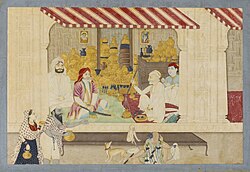Thathera
The Thathera (literally meaning 'the beater',[1] also known as Thathrias[2]) is a Hindu and Sikh artisan caste in India, whose traditional occupation is the making of brass and copper utensils.[3] In 2014, the craft of the Thathera community of Jandiala Guru was included in the UNESCO Intangible Cultural Heritage Lists.[4]
 Mid-19th century painting of a metalworking shop | |
| Regions with significant populations | |
|---|---|
| India | |
| Languages | |
| Hindi, Punjabi | |
| Religion | |
| Hinduism, Sikhism |
HistoryEdit
The Thathera communities of Punjab played a prominent role in developing the Sikh School of metal relief artwork.[1][2] Many of the surviving gilded brass and copper panels affixed to the edifices of the Golden Temple or Gurdwara Baba Atal Rai were crafted by Thathera craftsmen or guilds in the 19th and early 20th century.[1] The most renowned Thatheras for creating metal panel art were located in Kucha Fakirkhana, Lahore.[1] Only three or four Thathera families in Amritsar have preserved the knowledge on how to execute this form of metalworking art at present.[2]
Present circumstancesEdit
The Thathera community are divided into 47 clans. The main ones are Chauhan, Parmar, Gahlot, Mahecha Rathod, Vadher, Solanki, Bhatti, khasi, Kagda and Puvar. In Uttar Pradesh, they are found mainly in Lalitpur, Jalaun, Banda, Kanpur, Lucknow, Mirzapur and Indore M.p also In Bihar, they are found in the districts of Patna, Nalanda, Gaya, Nawada, Bhagalpur, Muzaffarpur, Munger, Purnea, Begusarai, Katihar, Khagaria, and Madhubani. The Bihar Thathera are divided into a number of exogamous clans such as the Chandrahar, Chaswar, Mirdang, Amarpallo, and Peswa.[5]
The Thathera are traditionally a community of artisans. Metal work, business and repair of utensils are their traditional occupations. Many of them even cultivate land, and in Bihar, many are also jewellers. In Odisha, they are called 'kansari' and the main ones of this community are the Maharana and the Mahapatra. Basically, they are involved with metal artisan works like 'brass', 'bronze', 'aluminium' and 'copper' etc.
In RajasthanEdit
The Thathera in Rajasthan are found in the districts Jodhpur, Alwar, Jaipur, Madhopur, Jaiselmer, Ajmer, Bikaner, Ujjain, Udaipur, Banswara and Dungarpur. They speak Khari Boli and wagri among themselves, and Rajasthani with outsiders.
- Ravegi
- Jhaghari
- Atlas Mewat
- Atlas Kuntkutia
- Atlas Patoria
- Atlas Gondhar
- Atlas Berenbal
- Atlas Chonkria
- Atlas Khankhapra
- Shadpalia
- Bhodia
- Vadia Chaksaka
- Mahendru Vadia
- Ravat
- Lilonia Moharia
- Mahale
- Chandoria Rafa
In HaryanaEdit
In Haryana, the Thathera claim to have been Rajput, who abandoned their traditional occupation and started to manufacture silver and gold coins. They immigrated from Rajasthan in the 19th Century and settled initially in Rewari. The community then took to manufacturing utensils. A small number of Thathera who are found in the town of Jagadhari, are said to have immigrated from Pakistan. The Haryana Thathera have fifty two clans. Their main clans are the Barawashli, Anant, Godomot and Ramgarhia. The community is strictly endogamous.[6]
In BiharEdit
In Bihar, the Thatheras are classified as a Backward Caste.[7]
UNESCO Listing and Government ProgramsEdit
Although people of the Thathera community reside across the country, only those from Jandiala Guru in the state of Punjab were included in the UNESCO's List of Intangible Cultural Heritage. [8]
After years of neglect and inaction on the part of the government and the civil society, the UNESCO listing prompted the Deputy Commissioner of Amritsar to collaborate with students of Shri Ram College of Commerce to revive the dying craft form.[9] Soon, Navjot Singh Sidhu, the then Minister of Tourism of Punjab pledged Rs. 10 lakhs to this effort, under the umbrella of Project Virasat.[10][11]
NamesEdit
Other names of the community include:[citation needed]
- Hindi-Thathera/Tamrakar/Tamera/Vadhera/hayaran, Tamta (Uttrakhand)
- Gujarati-Kansara
- Nepali-tamo/tamot/tamrakar,
- Punjabi-thatheri/thathiyar,
- Bangla-karmakar,
- Marathi-twastha tambat kasar
ReferencesEdit
- ↑ 1.0 1.1 1.2 1.3 Kang, Kanwarjit Singh (21 October 2007). "From metal to form". The Tribune - Spectrum.
- ↑ 2.0 2.1 2.2 Robin, Ravinder Singh (8 February 2010). "Artisans keep copper bas-relief art alive in Amritsar". Sikh Net.
- ↑ Singh, K S (2005). People of India: Uttar Pradesh. Vol. XLII. New Delhi: Anthropological Survey of India; Manohar Publishers. p. 1536. ISBN 978-8173041143. Part 3.
- ↑ "Traditional brass and copper craft of utensil making among the Thatheras of Jandiala Guru, Punjab, India", ICH UNESCO, UNESCO
- ↑ People of India Bihar Volume XVI Part Two edited by S Gopal & Hetukar Jha pages 766 to 769 Seagull Books
- ↑ People of India Haryana Volume XXIII edited by M.K Sharma and A.K Bhatia pages 490 to 493 Manohar
- ↑ Vidyarthi, Lalita Prasad; Prasad, Ramakant; Upadhyay, Vijay S. (1979). Changing Dietary Patterns and Habits: A Socio-cultural Study of Bihar. Concept. p. 11.
- ↑ Roy, Soumyadeep (13 December 2014). "Preserving India's living heritage for the future". Deccan Chronicle. Archived from the original on 30 June 2021. Retrieved 1 July 2019.
- ↑ "Delhi-based team comes to rescue of Thathera community". The Tribune. 14 September 2017.
- ↑ Yudhvir Rana (24 June 2018). "Age-old craft of thatheras to get new life". The Times of India. Retrieved 1 July 2019.
- ↑ GS Paul. "'Thatheras' of Jandiala Guru find saviour in minister". The Tribune.
